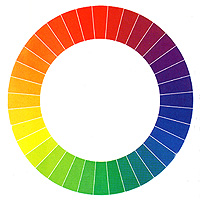Scientific studies have found out that our eye notices the color of an object first
Small jewelry science of colors
Scientific study - Small jewelry science of colors
Scientific studies have found out that our eye notices the color of an object first. The shape of the object is noticed after having noticed the color.
Colors do have a large influence on our emotions and can affect our emotions positively. Red for example lets the pulse frequency increase and rises the blood pressure . Blue works against it exactly in reverse. It calms down. Yellow improves our ability to concentrate and promotes communication.
In the conventional science of colors we define 3 colors as primary colors: Red, blue and yellow (Cyanide, Magenta and Yellow). These cannot be achieved by mixing other colors. Secondary colors are gained by mixing the 3 basic colours and Tertiary Colors by mixing the secondary colors.
Since colors do not really exist, but only reach our eye as a reflection of light, this science of colors has been developed and more differentiated. I do not want to go that much into detail but we should take a glance at some precious stones which can change their color substantially depending on the direction of the light which meets them (i.e. Opal, Moonstone, Labradorite). This characteristic can give your piece of jewelry an extraordinary touch
The circle of colours, shown underneath shows the meaning of colors: Complementary colors face each other in the circle; so for instance. turquoise and orange, red and green or yellow and violet.

Color combinations
With such color combinations the contrast is very strong. They increase mutually their effect on each other and obtain a very lively impression. A jewelry design, which possesses strong contrasts, is always loud and should be carried if possible as unique piece. A combination of earrings, necklace and bracelet is not of advantage here, maybe with few exceptions.
Decoration and clothes
With such jewelries also the selected clothes are very important. Black or white can be combined as „non-colors “well with remarkable jewelry. Also unicolored clothes which repeat one of the colors used with the piece of jewelry can be worn. A combination with patterned clothing affords intuitive feeling. So a dress or a blouse with jewelry in the same colors can become a great ensemble.
The Combination of neighbour colors of the circle like e.g. yellow and orange or green and blue, radiates the jewelries harmony. A tone on tone combination of different tones (secondary and tertiary colors) of the same color still increases the harmony, so e.g. different blue tones combined with one another will tremendously harmonize. If the selected colour fits with the color of the clothes, a set of earrings, necklace and bracelet will complete the entire appearance.
Color types and their seasons colors
Finally I would like to mention the theory of four different color types which was developed in the eighties. We differentiate four types dependent on the complexion of their skin and the color of the hair as well as the eye color: Spring, Summer, Autumn and Winter.
Spring and autumn colors consist of warm tones, whereby warm pastel shades are assigned to spring. So e.g. orange, brown and olive fits with autumn types - and salmon, beige or bright khaki are colors for the spring type. The summers and winter colors are cold and clear colors; for the summer for example stands light blue, violet, light rose and and grey while the classical winter should select clear contrasts with very cool colors : a bright blue, lilac, pink and for sure black and a white.
As far as precious metals are concerned spring and autumn types should wear yellow and red gold, brass and copper, while summers and winters look great with platinum, white gold and silver. With the help of this teachings you can present your own type in „the best light “. A wrongly selected color can e.g. let the skin look tired and pale, while another color reaches exactly the opposite.
This short outline does not lay a claim on completeness. There are always exceptions of the rule and often the borders are not clear, but I hope that I could give some useful tips which will support you in creating great jewelry.






